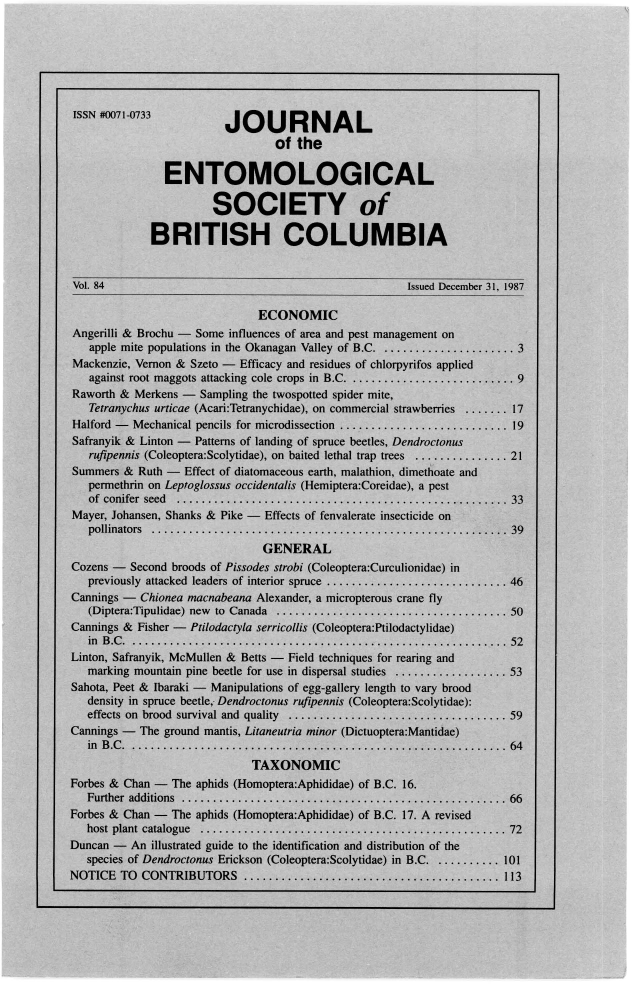Field techniques for rearing and marking mountain pine beetle for use in dispersal studies
Keywords:
mountain pine beetle, <i>Dendroctonus ponderosae</i>Abstract
Mountain pine beetles, <i>Dendroctonus ponderosae</i>, were marked with fluorescent (DayGlo) powders in vacuum chambers and on powder-covered brood trees in the field for use in release-recapture studies of dispersal behaviour. A large wall tent was used as a field insectary to accelerate late stages of development of large numbers of beetles in naturally infested bolts of lodgepole pine. Up to 28% of the marked beetles which flew were recovered from lethal trap trees. Beetles self-marked on powdered brood trees were captured in barrier traps in predicted proportions.
References
Chapman, J.A. and J. Kinghorn. 1958. Studies of flight and attack activity of the ambrosia beetle, Trypodendron lineatum (Oliv.), and other scolytids. Can. Ent. 90:362-372.
Dunn, Paul H. and Byron J. Mechalas. 1963. An easily constructed vacuum duster. J. Econ. Ent. 56(6):899.
Gangwere, S.K., W. Chavin, and F.C. Evans. 1964. Methods of marking insects, with special regard to Orthoptera (Sens. Lat.). Ann. Ent. Soc. Amer. 57:662-669.
Gara, R.I. 1967. Studies on the attack behavior of the southern pine beetle. I. The spreading and collapse of outbreaks. Contrib. Boyce Thompson Inst. 23(10):349-354.
Moffitt, H.R. and D.J. Albano. 1972. Vacuum application of fluorescent powders as markers for adult codling moths. Econ. Ent. 65:882-884.
Schmitz, R.F. 1980. Dispersal of pine engraver beetles in second growth ponderosa pine forests. In: A.A. Berryman and L. Safranyik (eds.). Proceedings of the Second IUFRO Conference on Dispersal of Forest Insects: Evaluation, Theory and Management Implications, Sandpoint, Idaho August 27-31, 1979.
Downloads
Published
Issue
Section
License
Authors who publish with the Journal of the Entomological Society of British Columbia agree to the following terms:
-Authors retain copyright and grant the journal right of first publication with the work simultaneously licensed under a Creative Commons Attribution License that allows others to share the work with an acknowledgement of the work's authorship and initial publication in this journal.
-Authors are able to enter into separate, additional contractual arrangements for the non-exclusive distribution of the journal's published version of the work (e.g., post it to an institutional repository or publish it in a book), with an acknowledgement of its initial publication in this journal.
-Authors are permitted and encouraged to post their work online (e.g., in institutional repositories or on their website) prior to and during the submission process, as it can lead to productive exchanges, as well as earlier and greater citation of published work (See The Effect of Open Access).


